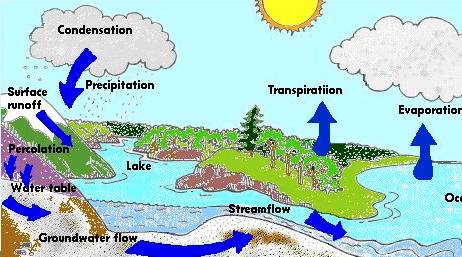| The Water Cycle |
|
In order to appreciate the nature and limits of water as a resource we need to have some understanding of its movement and availability throughout the world. This is shown simply below in the Hydrological (water) cycle. |

|
|
Freshwater exists in three systems: ground water (stored in the earth), surface water (icebergs, lakes, and rivers...) and atmospheric water found in fog, clouds or precipitation. All three systems work in an integrated way to maintain the level of fresh water. The system is cyclical, i.e. it replenishes itself through evaporation (from the oceans, river) precipitation (snow, rain.) and finally circulation back to ground water and the surface water. The water cycle is the continual movement of water around the earth, both in the oceans and in the air, this process is powered by the sun's energy. In the illustration above the sun's radiant energy supplies the power to evaporate water from lakes, rives, and plants. The water vapour is transported in the atmosphere via the winds that are also driven by the suns' energy. The water vapour condenses and returns to the land or sea as precipitation, rain, snow, etc. A large proportion of water vapour is actually returned to the ocean by precipitation before ever reaching land. Water deposited on land as precipitation percolates through the soil to the water table, recharging the groundwater. Some of the water is intercepted by vegetation and directly returned to the atmosphere as evaporation. Some water flows over land to lakes or back to the sea where again it may evaporate, and some waterfalls directly into rivers and lakes. Eventually, when the freshwater is returned to the sea, then the cycle is completed. |